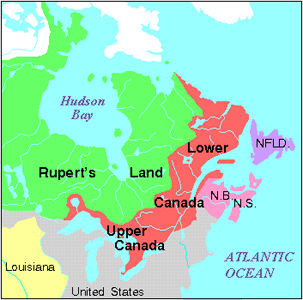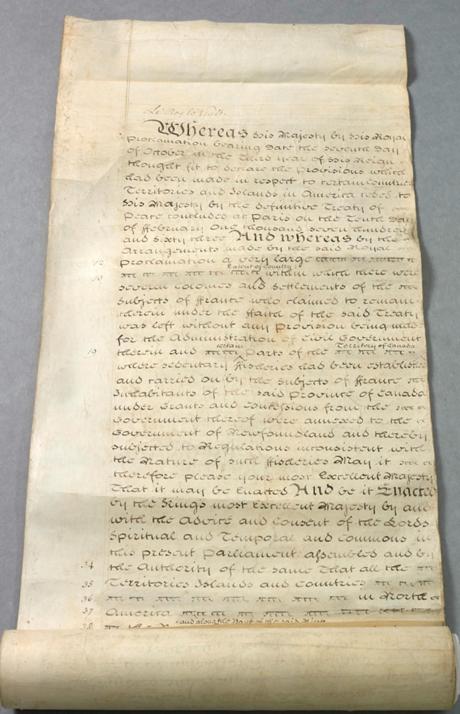The Constitutional Act, 1791 was an act of the British Parliament. Also known as the Canada Act, it divided the Province of Quebec into Upper Canada and Lower Canada. The Act was a first step on the long path to Confederation, but its rigid colonial structures also set the stage for rebellion in the Canadas. (See Rebellions of 1837–38.) The Act was also notable for giving women who owned property in Lower Canada the right to vote — a high level of inclusion by the standards of the time.

Response to Loyalist Immigration
The Constitutional Act received royal assent in June 1791 and came into effect on 26 December. It enshrined constitutional changes that were part of the reorganization of British North America. This took place as thousands of Loyalists were seeking refuge after the American Revolution. (See also Black Loyalists in British North America; Editorial: The Arrival of Black Loyalists in Nova Scotia.)
A constitutional bill was prepared by William Wyndham Grenville. It was modelled on legislation that had created the colonies of New Brunswick and Cape Breton in 1784. Grenville’s bill ensured that British parliamentary institutions would continue to develop in the region covered by the Quebec Act of 1774. According to Grenville, the bill’s purpose was to “assimilate” each colony’s constitution to that of Britain.

Province of Quebec Divided
The bill had four main objectives: 1) to guarantee the same rights and privileges that were enjoyed by other subjects in British North America; 2) to give colonial assemblies the right to levy taxes to pay for local civil and legal administration, thus easing the burden on Britain’s treasury; 3) to justify the division of the Province of Quebec into separate colonies (Upper and Lower Canada) with their own provincial legislatures; and 4) to strengthen the bonds of political dependency by fixing the constitutional weaknesses of previous colonial governments. This involved boosting the authority and prestige of the governor by making him a true representative of the Crown. It also meant limiting the powers of the elected assemblies by creating independent legislative councils made up of appointed members. These aristocratic bodies were modelled on the British House of Lords and were devoted to the interests of the Crown. (See also: Château Clique; Family Compact).
Foundation for Conflict
The Act guaranteed continuity of ownership of land held under the seigneurial system in Lower Canada. It also created the Clergy Reserves in Upper Canada.
By giving Upper Canada a constitution and a separate administration, and by favouring British settlement there, Britain took the first steps on the path that ultimately led to Confederation. However, the Act failed to establish responsible government. It also granted more financial powers to the appointed councils than to the elected assemblies. These factors created political conflict and contributed to the rebellions of 1837–38. (See also: Rebellion in Lower Canada; Rebellion in Upper Canada).

A Wider Franchise
Under the Act, voters were simply described as “persons” who were at least 21 years old and “natural” citizens or subjects of the monarch who had not been convicted of a serious criminal offense or treason. Voters were also required to own land or property of a certain value. (In urban areas, tenants could vote if they paid a minimum amount in rent.) This property value was set quite low in the late 18th and early 19th centuries. The result was a relatively broad franchise. And since women were not specifically excluded by the act, women who owned property were allowed to vote in Lower Canada.
English Common Law prevailed in most other British colonies, including Upper Canada. As a result, women there were excluded from voting. In Lower Canada, however, women’s property and inheritance rights were determined by the Coutume de Paris. Under French civil law, property was shared between husbands and wives, although it was administered by the husband. If the husband died, his widow received half of their shared property. Women in Lower Canada therefore had greater access to property than elsewhere in the British colonies.
As the Custom of Paris continued to apply to civil matters after 1791, women of property in Lower Canada could vote under the act. This was not always applied in practice, but between 1791 and 1849, women voted in about 15 districts in Lower Canada. In 1849, the legislature passed a bill that removed women’s right to vote. (See Women’s Suffrage.)
See also: Constitutional Act, 1791 Document; Constitution of Canada; Constitutional History; Constitutional Law.

 Share on Facebook
Share on Facebook Share on X
Share on X Share by Email
Share by Email Share on Google Classroom
Share on Google Classroom
